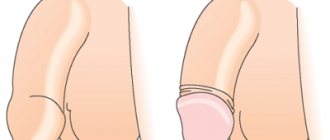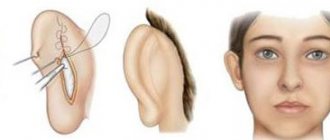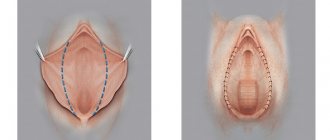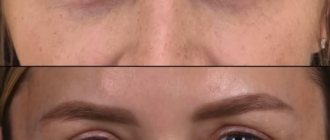Circumcision is the surgical removal of the foreskin of the penis. Since ancient times, circumcision has been considered a ritual rite of Jews and Muslims. This operation is perhaps the most ancient in the entire history of mankind. It is known that circumcision was widespread in ancient Egypt.
The rite of circumcision in the culture of many nations is equated with a celebration, a sign of acceptance into a religious community. This ritual is used as a symbol - initiation to transform a boy into a real man. This ritual is preceded by serious and lengthy preparation.
Don't waste your precious time - call!
Our specialists will be happy to answer all your questions
+7
In the second half of the last century, this operation became extremely popular in Western countries - it was performed on both infants and adult men. Almost a quarter of the world's newborn boys are circumcised. According to statistics, in America the vast majority (up to 90%) of newborns undergo this operation.
However, this procedure has not only supporters, but also opponents.
Arguments against circumcision
Among the arguments of opponents of this procedure are the following.
- This ritual is related to the religion of Jews and Muslims, therefore it is not typical for other nations, cannot and should not be used.
- Once upon a time, circumcision was practiced in southern countries due to high air temperatures, which made it difficult to perform hygiene procedures. Today there is no need for such extreme measures.
- It is a common belief that circumcision makes the head of the penis less sensitive. This statement has not received scientific substantiation.
What conclusions are drawn based on scientific assessments?
Based on the results of many studies, the following has been established.
In circumcised men, penile cancer develops much less often, several times, compared to those who have a natural foreskin.
Similar statistics are available for women, if the sexual partner is circumcised - cervical cancer is up to seven times less common in them.
Genital infections also develop less frequently in those who have undergone circumcision.
According to sex therapists, a circumcised penis looks more aesthetically pleasing and attractive - a neat head of the penis is perceived better than unaesthetic and wrinkled skin.
More hygienic, without a doubt, is an open head, because the possibility of accumulation of natural secretions and dirt is reduced to almost zero. This area no longer creates an environment conducive to the proliferation of any pathogenic microflora. As a result, the risk of developing inflammatory diseases - local and generalized inflammation and erosions - is greatly reduced.
A circumcised head leaves no chance of getting phimosis and balanoposthitis.
Matar Asaad Akhmadovich
Head of the center, professor, pediatric surgeon, urologist-andrologist
The main principle of our center is high professionalism, dedication to their profession, human participation and mutual understanding between specialists, young patients and their parents!
Go to doctor's page
Surgical methods
Circumcision refers to plastic surgery. Modern surgery offers several intervention options; the choice depends on the joint decision of the patient and the doctor.
- Partial. Often used for phimosis and paraphimosis. Only part of the foreskin is removed, allowing the glans to be exposed. At rest, it is half hidden by a fold of skin.
- Free. Fully opens the head of the penis. A groove is formed in the coronal region of the genitals.
- Minimal. This circumcision process is used for cicatricial phimosis or excessive growth of the foreskin. Only excess hanging skin is removed; at rest, the head is completely closed.
- Tight. The entire foreskin is cut off, the head is completely open. This circumcision procedure is carried out only after detailed consultations with a urologist; contraindications are possible.
- High. It is used for significant growth of the foreskin. The circular postoperative suture can be located at different heights.
- Low. The incision to remove the skin fold is made in the coronary groove, which also hides the postoperative suture.
Circumcision surgery is irreversible, so before starting it it is necessary to weigh all the advantages and disadvantages. Complications are rare; in some cases, allergies to medications or scarring are possible.
Arguments in favor of circumcision
- In countries where almost all men are circumcised, HIV infections occur in only 6% of the population. Conversely, in countries where the circumcision procedure is performed on a small number of residents (from 10 to 30%), this percentage is much higher - HIV carriers make up almost 1/4 of the population.
- Among men infected with AIDS, the overwhelming majority are uncircumcised. Doctors attribute this fact to the fact that microtraumas of the foreskin create a favorable environment for infection by the AIDS virus.
- Among men with hepatitis, the majority are also uncircumcised. The explanation for this fact also lies in the frequent occurrence of microtraumas of the foreskin, and the hepatitis virus affects precisely these areas.
- If the foreskin is excised, there is nowhere for the lubricant of the penis to accumulate - there are no conditions for the development of infection. Therefore, not only the risk of inflammatory diseases is reduced, but also sexually transmitted infections.
When do doctors recommend circumcision?
Excision of the foreskin is recommended if the patient has the following problems.
Phimosis is difficulty opening the head due to narrowing of the foreskin. For boys under three years of age, this condition is physiological; in the future, the problem may disappear on its own. Cicatricial phimosis – when the head can be opened only after surgery.
The diagnosis of cicatricial phimosis is made when a ball forms at the end of the penis. When urinating, the stream of urine is thin.
Phimosis is dangerous due to the risk of developing paraphimosis, when swelling of the penis occurs due to compression of the head. Gradually, tissue death occurs, and another operation is required - amputation of the penis.
Phimosis does not allow for good hygiene; lubricant accumulates in the folds, causing negative consequences.
Circumcision is also recommended in case of various neoplasms, genital warts and warts that appear on the frenulum, which can develop into malignant ones.
Balanitis and recurrent balanoposthitis are inflammation of the head of the penis and foreskin. The disease occurs due to neglect of hygiene rules and is accompanied by swelling, redness of the penis, painful urination, and discharge with pus. Surgery is recommended only if the disease enters the chronic phase and there is a danger of relapses and the formation of phimosis.
Multiple condylomas resemble viral papillomas and warts and are located on the foreskin or on the head of the penis. These growths are considered a precancerous condition, so the foreskin must be excised.
| aesthetic defect after circumcision | corrected aesthetic defect |
Rehabilitation period
During the first 5-7 days after the intervention, redness and swelling are observed at the excision site, nagging pain is periodically disturbed in the wound area, discomfort is felt when urinating and when the head and wound come into contact with linen. All these phenomena are considered normal, they are usually not very pronounced and allow you to carry out your usual activities at home without any problems.
In order to eliminate the inflammatory process and suture dehiscence, operated men need to:
- Take antibiotics and antibacterial agents according to the regimen prescribed by your doctor;
- Avoid situations where an erection occurs, as this may cause the edges of the wound to diverge;
- Give up sexual activity for 2-3 weeks;
- Treat the wound until complete healing with antiseptics recommended by the doctor;
- Avoid visiting baths and saunas for 3-4 weeks. You can only wash in the shower.
Physical activity during the rehabilitation period should be moderate. Heavy loads are prohibited, as they can lead to seams coming apart. There is usually no severe pain, but if necessary, analgesics can be taken in the first 1-2 days.
How is circumcision performed?
Over time, surgical instruments were improved and new techniques were introduced into practice. The operation is performed quickly - no longer than half an hour.
The doctor chooses the anesthesia: children are usually given general anesthesia, adults - spinal.
The wound is sutured with modern threads that do not need to be removed.
The choice of surgical technique affects the cosmetic result.
The following cutting methods are used.
Free technique – completely depends on the skill of the surgeon:
- What tools will he use (scissors or scalpel);
- How much fabric will he cut?
- How smooth will the seam be?
This technique is considered classic and is used in many countries.
Traditional circumcision. This technique does not require sutures. It is most widely used during ritual activities. In this case, there is a high risk of negative consequences in the form of:
- Prolonged bleeding;
- Infection and suppuration of the wound;
- High pain;
- Cosmetic defects;
- Rough scars;
- Healing often occurs by secondary intention as the edges of the wound separate.
Use of devices. Special tools have been developed. There are quite a lot of them, several dozen. For example, GomcoClamp and PlastiBell. It was initially assumed that after installing such “bells” the foreskin would fall off spontaneously within a few days. The technique is used for circumcision of newborns, but has a significant drawback: in practice, the foreskin does not always fall off and causes pain from which the child suffers. Most of these devices are not used.
Laser circumcision is the excision of the foreskin using a photodestructive method. The disadvantage of the technique is the long healing period due to thermal burns. Modern clinics do not use this method.
Partial circumcision (incomplete). Parents of boys often request excision of the foreskin, but not completely. As a result of this operation, the head of the penis remains covered and looks natural, uncircumcised. After this procedure, the risk of scarring and phimosis increases significantly. In order to minimize such consequences, our center has developed a special technique in which plastic surgery of the foreskin is performed with simultaneous plastic surgery of the frenulum of the penis. As a result, the risk of negative consequences is almost completely eliminated.
Our clinic uses a specially developed technique, the use of which is carried out taking into account the individual characteristics of each patient, regardless of age.
The use of a special clamp ensures a bloodless circumcision operation, the technology of which combines the advantages of traditional and latest techniques.
This approach to circumcision:
- Provides minimal tissue trauma, the operation is performed almost bloodlessly;
- Eliminates the risk of damage to the head of the penis (with the classical method this happens often, including in children's clinics);
- Provides a good cosmetic effect;
- Does not cause complications;
- The wound does not require long-term care during the first time after surgery.
If it is not possible to come for an in-person consultation, then you can send photographs of the penis from different sides so that the external opening of the urethra is clearly visible via E-mail, WhatsApp or Viber
Contraindications
- Hidden penis;
- Micropenis;
- Prematurity;
- Pseudohermaphroditism;
- Epispadias;
- Hypospadias;
- Anomalies in the development of the penis;
- Congenital coagulopathy;
- Hemophilia.
Author: Mamedov Rusif Bezhanovich Plastic surgeon, Candidate of Medical Sciences Received the “Grace” Award in the nomination “Best Plastic Surgeon for Facial Plastic Surgery”. Practices a unique endoscopic lifting technique, which is performed in the upper and middle zone of the face, as well as in its lower part.
Price and cost of phimosis surgery in children:
| Service | Price |
| Phimosis: Circumcision of the foreskin | 20000 |
| Phimosis (circumcision) with frenuloplasty | 35000 |
| Phimosis (circumcision) with meatal stenosis (urethral stenting) | 49000 |
| Phimosis (circumcision) with meatal stenosis (urethral stenting) and frenuloplasty | 65000 |
| Treatment of meatal stenosis (1st degree of complexity) | 39000 |
| Treatment of meatal stenosis (difficulty level 2) | 49000 |
| Treatment of meatal stenosis (grade 3) | 58000 |
The price list published on the website is not a public offer agreement. The provision of services is carried out on the basis of an agreement for the provision of medical services. You can find out the cost of the service during the consultation.
*The cost of the operation includes:
- inpatient placement 1 day
- all disposable surgical consumables and instruments
- application of an intradermal cosmetic suture - no need to remove the sutures!
- constant telephone communication with the attending physician
- examination any day in the clinic within 30 days after surgery
- all dressings included
The cost of the operation does not include:
- anesthesia care
- preoperative tests
Don't waste your precious time - call!
Our specialists will be happy to answer all your questions
+7
Our advantages
Experienced surgeons
Individual approach
Without pain and fear
Comfortable conditions
Preparation for the procedure
Circumcision of the foreskin in adults is performed on an outpatient basis or in a hospital.
- For adolescents, general anesthesia is used; adult men are more often given local anesthesia. Circumcision is impossible without anesthesia.
- Before the procedure, you must take a blood test to confirm the absence of infections and inflammation.
- If you have sexually transmitted diseases, you need to completely cure them and only then think about circumcision.
Before the operation, the penis is disinfected with special preparations and clamped with a tourniquet at the base. Anesthetics (lidocaine, ultracaine, killezin) are injected into the penis tissue with a thin needle.






